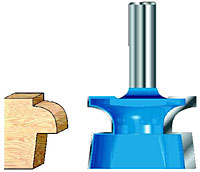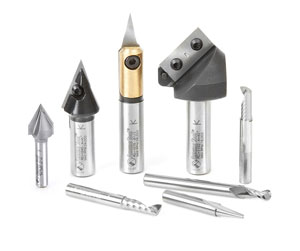Have you ever wondered if you can use router bits in a shaper? Well, you’re in luck because we’re here to explore that very question! So, can you put router bits in a shaper? Let’s find out together!
If you’re new to woodworking, you might be wondering what a shaper is. Think of it as a powerful machine designed to shape wood with precision and finesse. On the other hand, a router is a handheld power tool that can also shape wood, but it’s more versatile and portable.
Now, let’s get back to our original question. Can you put router bits in a shaper? Stay with us to uncover the answer and unlock the possibilities!
Discover the versatility of using router bits in a shaper! While it is technically possible to use router bits in a shaper, it is not recommended. Shapers are designed to work with specially-designed shaper cutters, which are sturdier and safer than router bits. Shaper cutters have a more robust construction and are specifically engineered for the higher speeds and forces generated by a shaper. Using router bits in a shaper can lead to safety issues and compromised performance. It’s best to use the proper tool for each application.

Can You Put Router Bits in a Shaper?
When it comes to woodworking tools, routers and shapers are two common options that professionals and hobbyists alike use to shape wood. Routers and shapers have different designs and functions, but one question that often arises is whether it’s possible to use router bits in a shaper. In this article, we will explore the compatibility between these two tools, their differences and similarities, and provide insights on whether you can put router bits in a shaper.
The Difference Between Routers and Shapers
Before we dive into the question of using router bits in a shaper, it’s important to understand the fundamental differences between these two tools. Routers are handheld or table-mounted tools that use a spinning bit to hollow out or shape wood. They are versatile and can handle a variety of tasks, including cutting decorative edges, creating intricate designs, and joinery work. On the other hand, shapers are stationary machines that use a rotating spindle with various cutter heads to shape and mold wood. Shapers are typically used for larger-scale projects, such as cabinetry, molding, and furniture making.
Compatibility of Router Bits in a Shaper
While routers and shapers serve similar purposes, their designs and mechanisms differ in significant ways. These differences make it generally impossible to directly use router bits in a shaper. The key factor that prohibits the interchangeability of router bits and shaper cutters is the size and mounting mechanism of the tools. Router bits typically have a 1/4-inch or 1/2-inch shank, while shaper cutters have a larger diameter and are designed to fit specific shaper models.
Moreover, shapers and routers have distinct speed requirements. Routers typically operate at higher speeds, while shapers run at slower speeds due to their larger cutters. Attempting to use a router bit in a shaper can lead to safety hazards, as the router bit might not be suitable for the lower speeds and the forces involved in shaping larger pieces of wood. It’s important to prioritize safety and efficiency by using the appropriate tool and cutter for each task.
Benefits of Using a Shaper
Although router bits cannot be used in a shaper, there are significant advantages to utilizing a shaper for certain woodworking projects. Shapers excel at handling larger and more complex tasks due to their sturdiness and stability. The stationary nature of shapers allows for precise and consistent shaping, making them ideal for producing intricate architectural details, moldings, and furniture components. Additionally, unlike handheld routers, shapers have the capacity to handle large-diameter cutters, enabling faster production without compromising quality.
Another benefit of using a shaper is its ability to work with a wide range of materials, including hardwoods, softwoods, and even plastic. This versatility makes shapers suitable for a variety of woodworking applications, from crafting custom doors and windows to creating unique designs for cabinetry. Shapers provide the necessary power, precision, and control needed to accomplish these types of projects efficiently and with impressive results.
Tips for Shaper Use
If you are considering investing in a shaper or already have one, here are some tips to enhance your woodworking experience:
- Choose the right cutter: Select the appropriate cutter for your desired shaping task, considering the profile, diameter, and material suitability.
- Ensure proper setup: Take the time to set up the shaper correctly, including aligning the fences, adjusting the height and depth of cut, and securing the material firmly.
- Use feed rollers: When working with long or wide pieces of wood, utilize feed rollers or other feeding mechanisms to ensure a consistent and controlled feed rate.
- Wear safety gear: Safety is paramount when using any power tool, including shapers. Always wear appropriate eye and ear protection, as well as a dust mask or respirator.
- Maintain and clean the machine: Regularly clean and lubricate your shaper to ensure optimal performance and longevity. Keep the cutting tools sharp and replace them when necessary.
Conclusion
While it may be tempting to think of shapers and routers as interchangeable tools, it’s important to recognize their distinct differences. Although you cannot put router bits in a shaper due to compatibility and safety reasons, shapers offer unique advantages in terms of stability, power, and precision. By understanding the capabilities and limitations of each tool, you can make informed decisions and achieve outstanding results in your woodworking projects.
Key Takeaways: Can You Put Router Bits in a Shaper?
- Yes, you can use router bits in a shaper, but only if they have a 1/2-inch shank size.
- Using router bits in a shaper offers versatility and allows for more intricate shaping options.
- Make sure to adjust the shaper’s RPM speed and feed rate to match the router bit being used.
- Take proper safety precautions, such as wearing protective gear and securing the workpiece firmly.
- Always refer to the manufacturer’s guidelines and instructions for using router bits in a shaper.
Frequently Asked Questions
If you’re wondering about using router bits in a shaper, you’re not alone. Here are some common questions people have about this topic.
1. Can I use router bits in a shaper?
While router bits and shaper cutters may look similar, they are designed for different machines. Router bits are intended for handheld routers, while shaper cutters are used in industrial shapers. The main difference lies in the power and stability of the machines. Shapers are more robust and can handle larger and more demanding woodworking tasks.
It’s important to use the right tool for the right job. Attempting to use a router bit in a shaper can result in poor performance, unsafe operation, and potential damage to both the bit and the machine. Always consult the manufacturer’s guidelines and use the appropriate cutters for your equipment.
2. What are the differences between a router and a shaper?
While routers and shapers are both woodworking machines used for shaping and profiling wood, there are key differences between them. Routers are handheld or table-mounted tools designed for smaller-scale projects and lighter-duty tasks. They offer more mobility and versatility, making them ideal for hobbyists and DIYers.
On the other hand, shapers are larger, stationary machines commonly found in professional woodworking shops. They provide more power, stability, and precision, making them suitable for heavy-duty operations on larger workpieces. Shapers can handle larger cutters, allowing for more intricate and complex profiles. Additionally, shapers offer better dust collection capabilities, ensuring a cleaner work environment.
3. What are the advantages of using a shaper over a router?
There are several advantages to using a shaper instead of a router. Firstly, shapers are more powerful and stable due to their larger size and heavier build. This allows them to handle larger and denser workpieces with ease, resulting in smoother and more precise cuts.
Secondly, shapers can accommodate larger cutters, enabling you to create more intricate and detailed profiles. The stability of the machine also allows for better control, reducing the risk of kickback and ensuring safer operation. Additionally, shapers often come with more advanced features and better dust collection systems, providing a cleaner and more efficient work environment.
4. Can I use a shaper for all the tasks I would typically do with a router?
While shapers are versatile machines, they may not be suitable for all tasks you would typically perform with a router. Routers are more portable and flexible, allowing you to work on smaller projects, trim edges, and create decorative details. They are also more accessible for hobbyists and those with limited space.
Shapers, on the other hand, excel in heavy-duty shaping operations, such as making large moldings, raised panels, or intricate profiles. They are commonly used in professional woodworking shops where precision and power are essential. Ultimately, the choice between a shaper and a router depends on the scale and complexity of your woodworking projects.
5. Are there any safety precautions I should take when using a shaper?
When working with a shaper, safety should always be a top priority. Here are some important precautions to follow:
Always wear appropriate safety gear, including safety glasses, hearing protection, and a dust mask. Make sure the machine is properly set up and securely mounted. Never operate a shaper without the necessary safety guards and shields in place. Keep your hands and fingers away from the cutter, and use push sticks or featherboards to maintain a safe distance. Avoid wearing loose clothing or jewelry that could get caught in the machine. Finally, familiarize yourself with the machine’s operation manual and follow all safety guidelines provided by the manufacturer.

Summary
So, can you put router bits in a shaper? The answer is yes, but with caution.
While it is possible to use router bits in a shaper, there are some important factors to consider. Shapers and routers have different designs and capabilities, so you need to ensure that the router bit is compatible with the shaper.
Additionally, the setup and operation of a shaper are different from a router, so it’s crucial to follow proper safety guidelines and procedures. It’s always best to consult the manufacturer’s instructions and seek guidance from experienced professionals to ensure a safe and successful operation.
